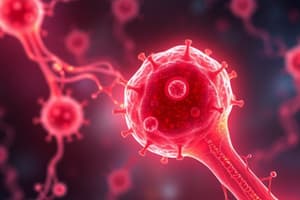Podcast
Questions and Answers
Which of the following statements accurately describes the process of cell differentiation?
Which of the following statements accurately describes the process of cell differentiation?
- Differentiated cells can easily revert back to stem cells and change into other cell types.
- Stem cells randomly change into different cell types without any specific signals.
- All genes are activated equally in every cell, leading to the formation of different cell types.
- A stem cell becomes a specialized cell type due to the activation of specific genes. (correct)
Once a somatic cell differentiates, it can readily revert back to an undifferentiated state and become any other cell type.
Once a somatic cell differentiates, it can readily revert back to an undifferentiated state and become any other cell type.
False (B)
What is the primary function of red blood cells, and how does their structure support this function?
What is the primary function of red blood cells, and how does their structure support this function?
Red blood cells primarily transport oxygen and remove carbon dioxide. They lack a nucleus and mitochondria to maximize space for hemoglobin, which carries oxygen.
Muscle cells require increased amounts of ___________ to support their function of movement.
Muscle cells require increased amounts of ___________ to support their function of movement.
Match the following cell types with their primary function or characteristic adaptation:
Match the following cell types with their primary function or characteristic adaptation:
Flashcards
Cell Differentiation
Cell Differentiation
The process where a stem cell transforms into a specialized cell type with a specific function.
Reversibility of Differentiation
Reversibility of Differentiation
Once differentiated, a cell's developmental path is typically fixed, though research explores reversing this.
Gene Activation in Differentiation
Gene Activation in Differentiation
While all somatic cells share the same DNA, differentiation occurs because only specific genes are activated in each cell type, determining its structure and function.
Red Blood Cell Adaptations
Red Blood Cell Adaptations
Signup and view all the flashcards
Muscle Cell Adaptations
Muscle Cell Adaptations
Signup and view all the flashcards
Study Notes
- Differentiation is the process where a stem cell becomes a specialized cell
- A variety of cell types can be produced, forming cells that depend on the complexity of the organism
Can Cell Differentiation Be Reversed?
- All cells contain the same DNA
- Pluripotency allows stem cell specialization.
- This means that after a stem cell has undergone the process of differentiation, it adopts a specific role and loses its ability to return to its unspecialized state.
How Does Differentiation Happen?
- All somatic cells have the same DNA, but only certain genes are activated
- Active genes determine cell structure, function, and organelle composition of a cell
Inside the Cell – Structural and Functional Changes
- Specialized cells undergo significant modifications to their organelles to enhance their functionality. For instance, muscle cells adapt by increasing the number of mitochondria, which are essential for ATP production, thus enabling them to generate greater amounts of energy necessary for contraction and movement.
- Some cells, like red blood cells, lose organelles to optimize function
- Cells may change shape or develop new structures
Specialized Cells & Their Functions
Red Blood Cells
- Function: Transportation of oxygen, removal of CO2 and cellular waste
- Lose nucleus and mitochondria to maximize space for hemoglobin
- Shape: Long
Muscle Cells
- Function: Movement
- Increased amounts of mitochondria and abundant proteins specialized for muscle contractions
Nerve Cells
- Function: Transmit impulses to maintain movement in the body
- Large nucleus, numerous vesicles (transportation), and increased mitochondria
- Shape: Extensions help with transportation of signals
Bone Cells
- Function: Provide Support and more
- Osteoblasts build bone using rough ER and Golgi
- Osteoclasts break down bone using Lysosomes
Studying That Suits You
Use AI to generate personalized quizzes and flashcards to suit your learning preferences.
Related Documents
Description
Explore cell differentiation, where stem cells specialize. Understand how cells with identical DNA diversify through gene activation. Learn about structural changes and specialized cell functions.




